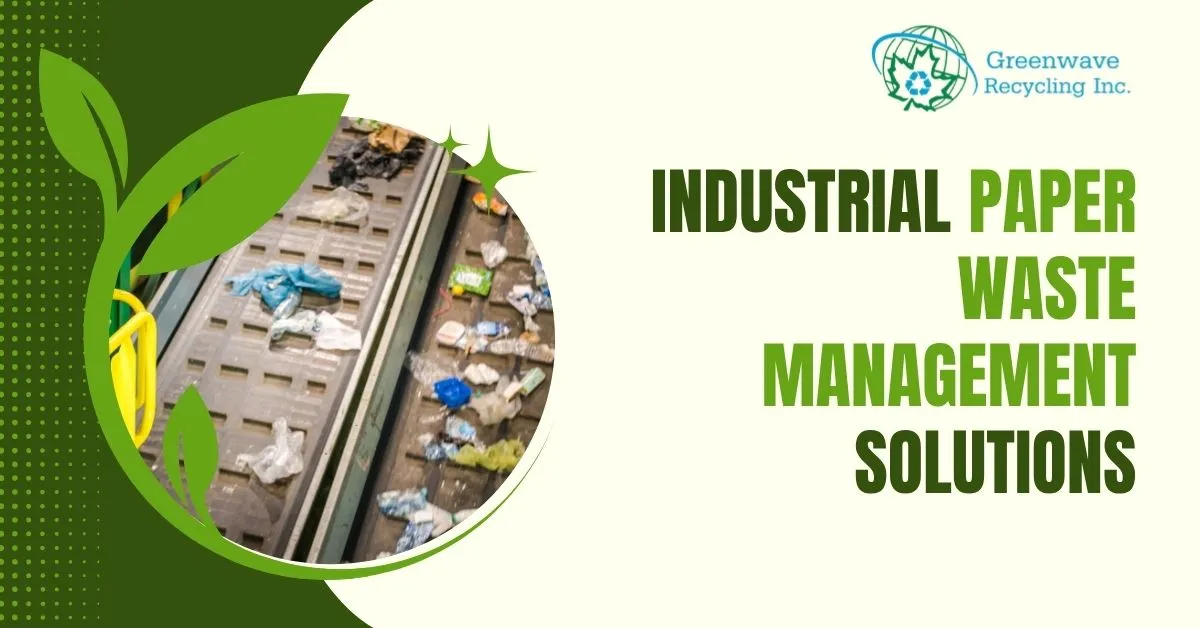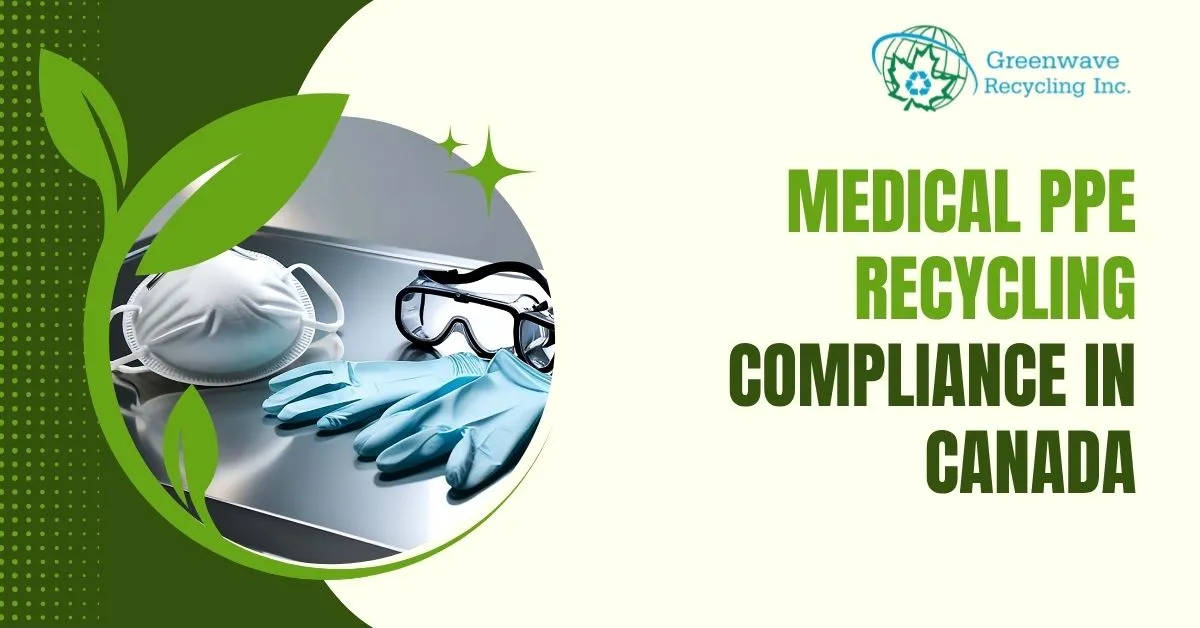The rise in disposable personal protective equipment (PPE) such as gloves, masks, gowns, and face…

Paper continues to play a vital role in Canada’s industrial, commercial, and institutional sectors. From packaging and office use to large-scale printing and manufacturing, paper is one of the most consumed materials nationwide. However, the disposal of industrial paper waste presents both environmental and financial challenges. With Canada’s growing commitment to sustainability and a circular economy, industries are turning to smarter paper waste management solutions that reduce costs, ensure compliance, and protect the environment.
In this blog, we’ll explore the importance of industrial paper waste recycling, the benefits for Canadian businesses, and the sustainable practices shaping the future of waste management across the country.
Why Industrial Paper Waste Management Matters?
Industrial operations in Canada generate tonnes of paper waste every year. While residential recycling is well established, industrial and commercial paper disposal often requires specialized solutions. Without proper management, paper waste contributes to:
- Increased landfill volumes that put pressure on municipal waste facilities.
- Higher greenhouse gas emissions due to decomposition and transportation.
- Lost opportunities to recover fibre that could be recycled into new paper products.
By implementing effective industrial paper recycling programs, Canadian businesses can reduce environmental impact while gaining operational efficiencies.
Types of Industrial Paper Waste in Canada
Industries generate a wide variety of paper waste, much of which can be recovered and recycled. Common categories include:
- Corrugated Cardboard (OCC): Widely used in packaging, shipping, and warehousing.
- Mixed Office Paper: Printed documents, envelopes, and copier waste.
- High-Grade Paper: Shredded paper, letterhead, and printer cuttings.
- Paperboard & Cartons: Used in food, retail, and manufacturing packaging.
- Specialty Paper Waste: Laminated sheets, coated papers, and paper with adhesives.
Recognizing the different types of industrial paper waste is the first step in developing an efficient waste diversion program.
Benefits of Industrial Paper Waste Recycling
Recycling paper waste is not just about environmental responsibility; it also creates tangible benefits for Canadian industries:
1. Environmental Protection
Paper recycling reduces the need for raw pulp production, protecting forests and lowering carbon emissions.
2. Cost Reduction
Diverting paper from landfills lowers tipping fees and disposal costs for industrial facilities.
3. Regulatory Compliance
Waste diversion supports compliance with Canadian environmental regulations and provincial recycling mandates.
4. Corporate Sustainability Goals
Companies can align with ESG (Environmental, Social, and Governance) goals by reporting on waste diversion efforts.
5. Recycled Material Supply
Recovered fibres re-enter Canada’s paper supply chain, reducing reliance on virgin materials.
Looking for reliable paper waste recycling solutions in Canada? Contact us to reduce costs and achieve your sustainability goals.
Industrial Paper Waste Management Solutions in Canada
Canadian businesses have access to a wide range of paper waste management services. These solutions are tailored to meet the needs of manufacturers, warehouses, institutions, and corporate offices.
1. On-Site Paper Collection Programs
Industrial facilities can set up custom collection bins and balers to separate paper waste directly at the source. This improves recycling rates and prevents contamination.
2. Secure Shredding and Recycling
For industries handling sensitive documents, confidential shredding services ensure security while diverting paper waste into the recycling stream.
3. Bulk Cardboard Recycling
Warehouses and distribution centres generate large volumes of cardboard. Baling and compacting OCC on-site makes transportation more cost-effective.
4. Waste Audits and Consulting
Professional waste audits help Canadian businesses assess their current waste streams and identify opportunities for greater recycling efficiency.
5. Partnering with Certified Recyclers
Working with certified recycling companies ensures compliance with Canadian environmental standards and guarantees that paper waste is processed responsibly.
Role of Technology in Paper Waste Management
Advancements in recycling technology are transforming how Canadian industries handle paper waste. Key innovations include:
- Automated Sorting Systems: Improve the separation of paper grades at material recovery facilities (MRFs).
- Energy-Efficient Pulping: Lowers energy use in recycling plants, reducing overall emissions.
- Digital Tracking Systems: Provide businesses with data on waste volumes, diversion rates, and compliance.
Technology not only improves recycling rates but also helps businesses meet reporting requirements for sustainability and ESG frameworks.
Challenges in Industrial Paper Waste Recycling
Despite progress, businesses still face challenges in managing paper waste effectively:
- Contamination: Food residue, plastics, or adhesives can reduce paper recycling quality.
- Transportation Costs: Canada’s vast geography makes logistics a challenge for some industries.
- Fluctuating Market Demand: Prices for recycled paper fibre can rise and fall, impacting program costs.
Overcoming these challenges requires partnerships with recycling companies that have nationwide logistics, strong end-market connections, and sustainable processing methods.
How Canadian Industries Can Improve Paper Waste Management?
For businesses seeking to strengthen their recycling programs, here are practical steps:
1. Conduct a Waste Audit – Identify paper waste volumes and types.
2. Educate Employees – Train staff on proper sorting and recycling practices.
3. Invest in Recycling Equipment – Use compactors, balers, and collection bins.
4. Choose the Right Partner – Work with recyclers who provide compliance documentation and nationwide services.
5. Set Measurable Goals – Track diversion rates and integrate results into ESG reports.
By following these steps, Canadian businesses can reduce costs, protect the environment, and build stronger reputations as sustainable leaders.
Frequently Asked Questions
Most paper waste, including cardboard, office paper, and high-grade fibres, can be recycled when properly sorted.
Recycling lowers landfill tipping fees and can generate revenue from selling baled cardboard and paper.
Recycling regulations vary by province, but most encourage or require industrial waste diversion programs.
Yes, shredded paper can be recycled if collected separately and processed by certified recyclers.
Certified recyclers provide documentation and reports for compliance and ESG reporting.
Conclusion
Industrial paper waste management is essential for building a sustainable and cost-efficient future in Canada. By recycling paper waste, businesses reduce their environmental footprint, support compliance with Canadian regulations, and strengthen their ESG commitments. With advanced technology, nationwide logistics, and certified recycling partners, Canadian industries can move closer to a circular economy where resources are reused instead of wasted.


